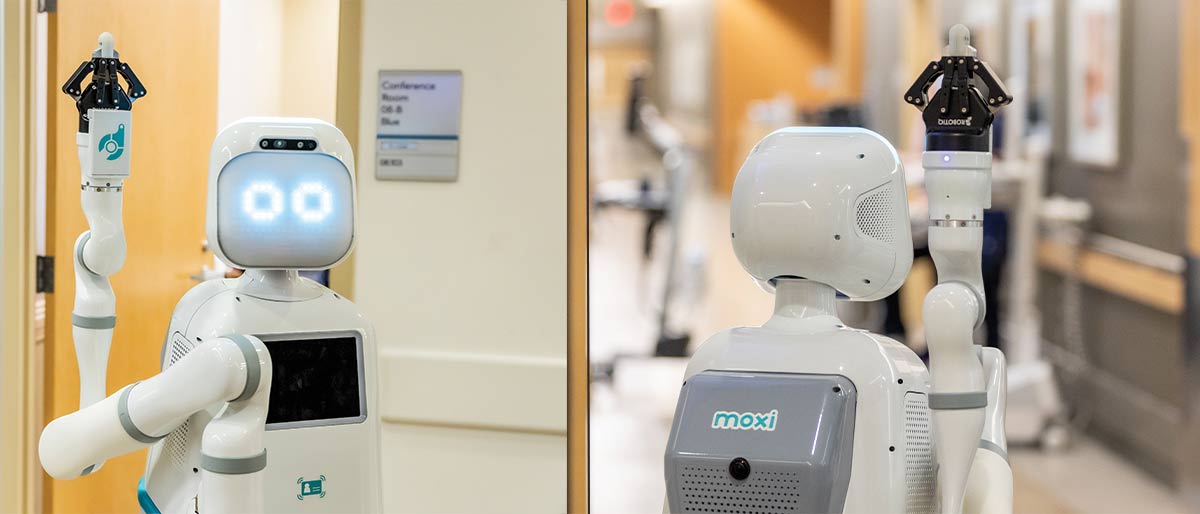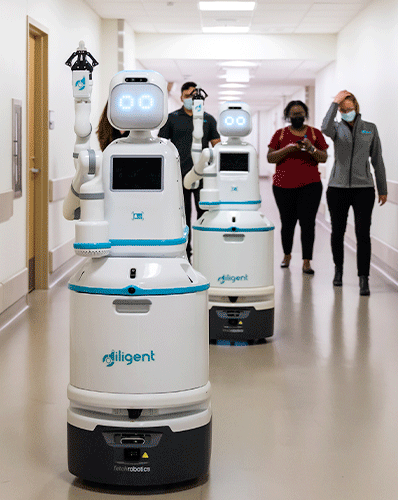A fresh face with a different kind of “moxie”
Pilot project using robots for deliveries frees up more time for nurses and patient care technicians to assist patients

With eyes that light up and turn into hearts, Moxi is hard to miss as the robot rolls down the halls of William P. Clements Jr. University Hospital.
But there is more to Moxi than a friendly digital face. Moxi 1 and Moxi 2 are designed to perform tasks that make it possible for nurses and patient care technicians to spend more time with their patients, said Matthew Terbeek, B.S.N., RN-BC, Manager of Clinical Informatics.

“Instead of leaving their unit and walking across campus, a nurse can dispatch Moxi to perform the task,” he said. It is estimated that Moxi will give nurses up to 30% of their shift time back by picking up some of their duties – all noncritical, routine tasks that do not require direct patient interaction, such as collecting lab specimens from neonatal intensive care and newborn units for transport to labs.
Currently, Moxi’s primary workflow is to deliver remote telemetry boxes (portable heart monitors) from the Central Monitoring Unit to nursing units. Kiosks, located at every nursing unit, make it easy to request a delivery, Mr. Terbeek said. When Moxi arrives at the unit, a nurse places the telemetry box in one of three locked drawers on Moxi before sending the robot on its way. (Patients and visitors cannot access the locked drawers on the robot unit.)
The robots are programmed to travel through the hospital on their own. Sensors help them effectively navigate through halls and in elevators.
As hospital staff members become more familiar with Moxi and its capabilities, additional tasks may be added. Although Moxi does not have verbal conversations with people, the robots can communicate simple messages, Mr. Terbeek said.
“Moxi doesn’t really talk to you, so if you try to interact with it, it doesn’t respond,” he said. “But when it arrives for an order, it can say, ‘I’m here for a pickup.’”
For several months, the Nursing Informatics Team worked to ensure that Moxi was providing value. The team is evaluating Moxi's effectiveness, tracking Moxi’s every move, recording how long each delivery takes and collecting data to ensure the robot is helpful to nurses, Mr. Terbeek said. Once the data is tabulated, additional workloads and robots may be added, depending on an analysis of the information.
So far, the robots have been well utilized.
Watch Moxi at work helping UT Southwestern nurses:
In the first three months, Moxi completed 6,463 deliveries in 2,859 hours. Currently, Moxi completes more than 500 deliveries a week and is trending upward as usage grows.
“Moxi has returned valuable time that is now devoted toward patient care,” said Michelle Warr, a Monitoring Technician with the Central Monitoring Unit.
“It saves us time on the long walk from 6 Orange to the Central Monitoring Unit and keeps staff on the floor to take care of our own patients,” added Marites Yanto, M.S.N., RN, CMSRN, 6 Orange Nurse Manager. “Everyone loves to see Moxi deliver, and it picks up efficiently. It works really well and is easy to use.”
Before Moxi started working in December, nurses in every unit trained with the robots and learned best practices for use. The response was very positive, Mr. Terbeek said.
“Not only is Moxi cute, with eyes that turn to hearts every once in a while, but the robot is also very friendly to work with,” he said. “Nurses were able to get selfies with Moxi before the robot went to work.”

